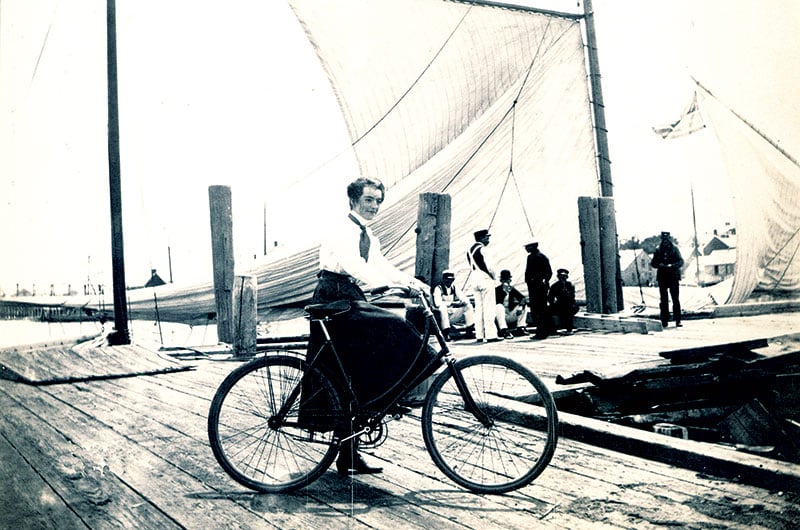• This Week in Nantucket History – by Amy Jenness – author of On This Day in Nantucket History, available at Mitchell’s Book Corner •

In an Inquirer & Mirror article on bicycling, Max Wagner wrote on June 13, 1896, “The miracle that the bipede has wrought all over the civilized world has probably been nowhere more pronounced than on this beloved sand heap of ours, that the world generally knows as the island of Nantucket.”
The first bicycles arrived on Nantucket in the 1880s and were so heavy few people wanted to ride them. Wagner noted they, “must have weighed seventy or eighty pounds, and would probably shy its rider into the gutter as quickly as would a bucking bronco.” Gradually the bicycles got lighter and by the early 1890s four Nantucket men purchased the lighter weight Eagle and started the island’s love affair with bicycles.
Wagner was one of them and wrote, “After a little practice the four of us could go down Federal Street abreast, though we had to drop back into single file to turn around. This maneuver we used to repeat many times, and the whole town turned out to watch us.”
Within a week 12 more Nantucketers had purchased bicycles and the new riders formed a bicycle club called Weeweeders. Soon the newspapers ran weekly items naming those who were taking up “the wheel.” In 1891 an editorial urged visitors to bring their bicycles to Nantucket. By 1896 there were six bicycle clubs, with the Weeweeder Cycle Club being the largest.
Beginning in 1893, the Weeweeders hosted autumn bicycle races at The Fairgrounds and at the County Fair. In 1894 the club offered a parade and race at the roller skating rink on Thanksgiving, which the Inquirer & Mirror described by saying, “Each of the wheels was trimmed with bright colors, and the effect was very charming. The parade was very well done and brought forth applause.” When the bicycles races concluded, Barrett’s Orchestra began to play and the crowd danced until 1 a.m.
An increase in mishaps caused town voters to create a law in 1894 that fined bicycle riders twenty dollars if they didn’t have a bicycle bell when they were riding faster than ten miles an hour, riding at night or on the sidewalk.
In 1895 Weeweeder member Eugene Burgess opened a bicycle shop on Federal Street and built a quarter mile racetrack on Orange Street near the current Marine Home Center. Opened on the eve of a three-day centennial celebrating the town’s name change from Sherburne to Nantucket, Burgess named his sporting center Centennial Park. Soon island cyclists were competing against each other there and travelling to race off island.
All over the country people embraced the bicycle boom. In 1897 the Inquirer & Mirror ran an article under the headline “Bicycle Crowds Out The Accordion” which reported that declining sales of accordions and other musical instruments could be attributed to the sharp increase in bicycle sales. The newspaper ran other articles about inventions designed to make bicycles useable on railroad tracks, a “trolley bicycle” that connected to wires overhead and hung suspended over the street, a “bicycle boat” powered by three cyclists and an adventurous California man who outfitted his bicycle with a mast and sail.
Road tarring and improvements made cycling easier, and by 1900 the town had created paths for cyclists in Surfside, ‘Sconset, and Cliff Road. In 1918 voters narrowly defeated a controversial ban on automobiles and soon cars, horses, and bicycles shared Nantucket’s narrow streets. Yet people still enjoyed their bicycles, and bike races continued to be a highlight of island life into the new century. The newspaper noted a renewed interest in bicycling beginning in the late 1930s and lawmakers debated requiring cyclists to register and install headlights. The manufacture and sale of bicycles was banned by the US government during World War II and when they were once again available in 1945 the island experienced another bicycle boom.
In 1957, Nantucket’s representative to the state Legislature, Robert F. Mooney, submitted a bill asking the Massachusetts Public Works Department to build a bike path on Nantucket, noting the island had more the 4,100 registered bicycles. If the bill was approved, it would create the country’s first state-funded bicycle path.
As the Senate Ways and Means Committee debated the idea, Dr. Paul Dudley White, President Dwight Eisenhower’s cardiologist, wrote Mooney a letter saying that, if his bill was passed, he would like to participate in the first bicycle ride on the new Nantucket path.
The following year in August Dr. White and State Representative Mooney were joined by 25 bicyclists as they made the inaugural run on the Milestone Road bike path, which ended shortly before Nobadeer Road at that point. At the dedication ceremony Dr. White, an avid cyclist, said he hoped Nantucket would set an example for the rest of the country and that soon there would be a network of bicycle paths similar to the country’s system of highways. There is a national organization that has had some success in making Dr. White’s vision a reality. On Nantucket, 57 years after opening the Milestone bike path, there are now 12 other bike paths, covering a combined total of 30 miles.
Visit Nantucket.net for descriptions and a map of the bicycle paths on Nantucket.